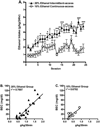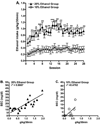Varenicline, a partial agonist at neuronal nicotinic acetylcholine receptors, reduces nicotine-induced increases in 20% ethanol operant self-administration in Sprague-Dawley rats
- PMID: 21392178
- PMCID: PMC3115414
- DOI: 10.1111/j.1369-1600.2010.00309.x
Varenicline, a partial agonist at neuronal nicotinic acetylcholine receptors, reduces nicotine-induced increases in 20% ethanol operant self-administration in Sprague-Dawley rats
Abstract
Alcohol and nicotine use disorders are often treated as separate diseases, despite evidence that approximately 80-90% of alcohol dependent individuals are also heavy smokers. Both nicotine and ethanol have been shown to interact with neuronal nicotinic acetylcholine receptors (nAChRs), suggesting these receptors are a common biological target for the effects of nicotine and ethanol in the brain. There are few studies that have examined the effects of co-administered nicotine and ethanol on the activity of nAChRs in rodents. In the present study, we show that Sprague-Dawley rats, a strain often used for nicotine studies but not as often for voluntary ethanol intake studies, will consume 20% ethanol using both the intermittent-access two-bottle-choice and operant self-administration models without the need for sucrose fading. We show that nicotine (0.2 mg/kg and 0.8 mg/kg, s.c.) significantly increases operant 20% ethanol self-administration and varenicline (2 mg/kg, s.c), a partial agonist at nAChRs, significantly decreases operant ethanol self-administration and nicotine-induced increases in ethanol self-administration. This suggests that nAChRs play an important role in increasing ethanol self-administration and that varenicline may be an efficacious treatment for alcohol and nicotine co-dependencies.
© 2011 The Authors, Addiction Biology © 2011 Society for the Study of Addiction.
Conflict of interest statement
The authors declare that, except for income received from my primary employer. S.E.B. has received financial support for research for a varenicline clinical study but has not received compensation from any individual or corporate entity over the past three years for research or professional service and there are no personal financial holding that could be perceived as constituting a potential conflict of interest.
Figures




References
-
- Amit Z, Stern MH, Wise RA. Alcohol preference in the laboratory rat induced by hypothalamic stimulation. Psychopharmacologia. 1970;17:367–377. - PubMed
-
- Barrett SP, Tichauer M, Leyton M, Pihl RO. Nicotine increases alcohol self-administration in non-dependent male smokers. Drug Alcohol Depend. 2006;81:197–204. - PubMed
-
- Batel P, Pessione F, Maitre C, Rueff B. Relationship between alcohol and tobacco dependencies among alcoholics who smoke. Addiction. 1995;90:977–980. - PubMed
-
- Blomqvist O, Ericson M, Johnson DH, Engel JA, Soderpalm B. Voluntary ethanol intake in the rat: effects of nicotinic acetylcholine receptor blockade or subchronic nicotine treatment. Eur J Pharmacol. 1996;314:257–267. - PubMed
-
- Blomqvist O, Soderpalm B, Engel JA. Ethanol-induced locomotor activity: involvement of central nicotinic acetylcholine receptors? Brain Res Bull. 1992;29:173–178. - PubMed
MeSH terms
Substances
Grants and funding
LinkOut - more resources
Full Text Sources
Medical

